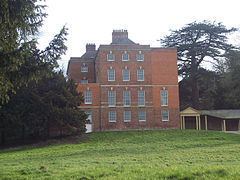Population 1,060 (in 2011) Civil parish Netheravon Dialling code 01980 Post town Salisbury | OS grid reference SU148487 Unitary authority UK parliament constituency Devizes | |
 | ||
Netheravon is a village and civil parish on the River Avon and A345 road, about 4 miles (6.4 km) north of the town of Amesbury in Wiltshire, South West England. It is within Salisbury Plain.
Contents
- Map of Netheravon UK
- Governance
- Notable people
- Parish church
- Netheravon House
- Cavalry School
- Aviation operations and training
- Avon Camp
- References
Map of Netheravon, UK
Governance
The village is the most populous part of 'The Collingbournes and Netheravon' electoral ward. This ward starts in the west at Netheravon, stretches east to Collingbourne Ducis and ends in the east at Chute Forest. The population of this ward at the 2011 census was 4,186.
Notable people
The writer Frank Sawyer (1906–1980), although born in Bulford, spent most of his life in Netheravon as a river keeper on the Avon and died on the banks of the river near the parish church. He developed the Pheasant Tail Nymph for fly fishing and wrote the books Keeper of the Stream and Nymphs and the Trout.
Parish church
The Anglican Church of All Saints dates from the 11th century and is Grade I listed.
Netheravon House
Netheravon House, built in the 18th century for the Beech family and extended in 1791 by John Soane, is Grade II* listed. Evidence of a Roman villa has been found on part of its site. An 18th-century dovecote stands in the grounds to the north of the house. In 1898 Michael Hicks Beach sold the house and estate to the War Office.
Cavalry School
Military activity was first established at Netheravon in 1904 with the creation of a cavalry school under the sponsorship of Major General Robert Baden-Powell as the Inspector General of Cavalry. Baden-Powell envisioned developments in the use of Cavalry following his experiences in Southern Africa and India, and lessons from the Second Boer War. The school emphasised the use of cavalry for scouting and reconnaissance, recognising that the traditional effects of mass of cavalry had been diminished by the availability of modern weapons. The Officers' Mess was established at Netheravon House.
Aviation operations and training
Netheravon Airfield is outside the parish, on the other bank of the Avon in Fittleton and Figheldean parishes. A grass strip airfield was created for the Royal Flying Corps northeast of Coulston Camp (later called Airfield Camp) in 1913 and later became RAF Netheravon, an operational and training base. It was the home of No. 1 Flying Training School RAF from 1919 until 1931, and during the Second World War was used again for training and as a short-term base for operational squadrons, with glider and parachute activity from 1941. In 1963 the airfield and camp were transferred to the Army, and became AAC Netheravon (Army Air Corps) from 1966 until 2012.
Avon Camp
With the establishment of the Airfield in 1912 the Cavalry School continued to operate in the remaining training areas until the beginning of the war, re-opening briefly in 1919. In 1922 the school amalgamated with the Royal Artillery Riding Establishment in Northamptonshire and the location was taken over by the Machine Gun School, following a move from Grantham.
The Machine Gun School was absorbed as an element of the Small Arms School Corps in 1926. Over time the school expanded to encompass support weapons in general, becoming the Support Weapons Wing of SASC. Support Weapons Wing remained at Netheravon until 1995 when Avon Camp was closed and the Wing moved to the Land Warfare Centre, Warminster.
Courses at Avon Camp included the use of:
